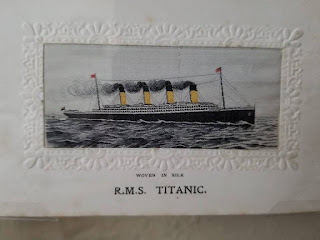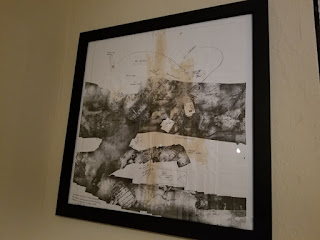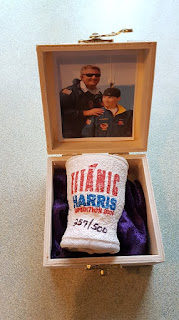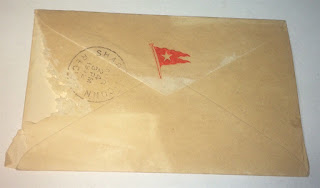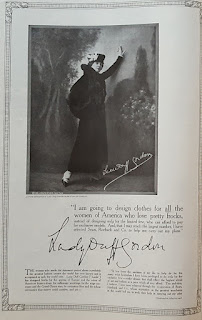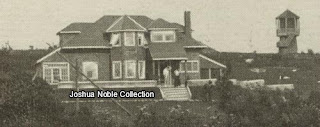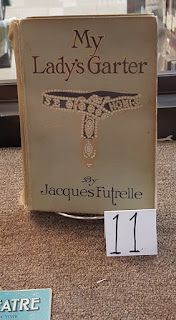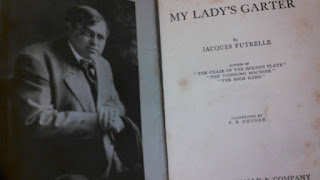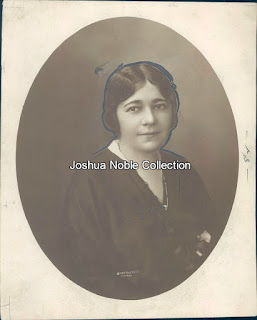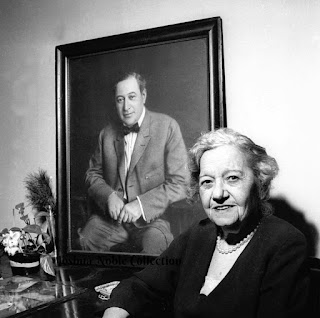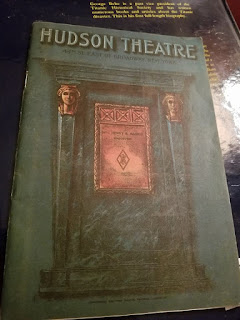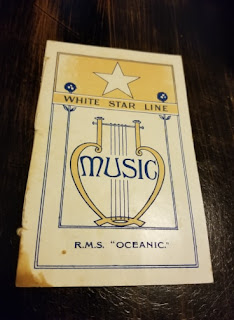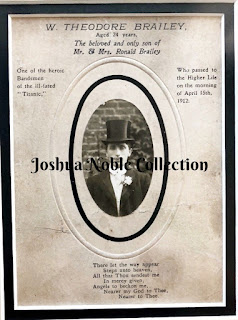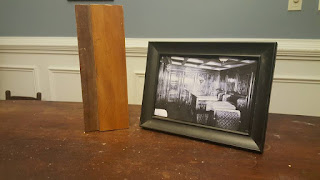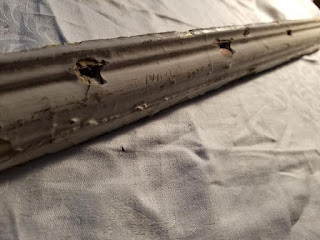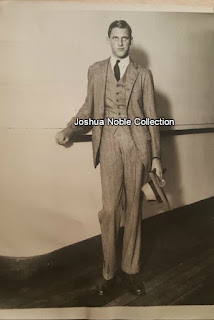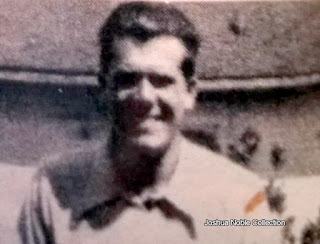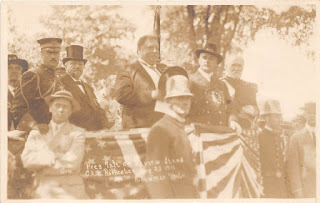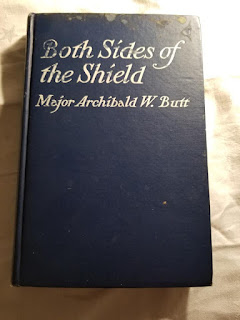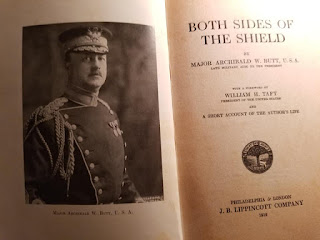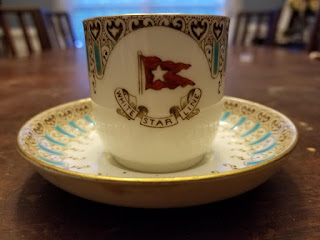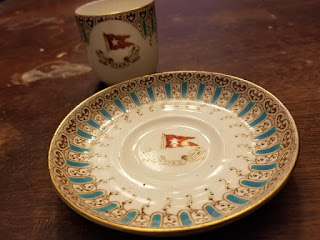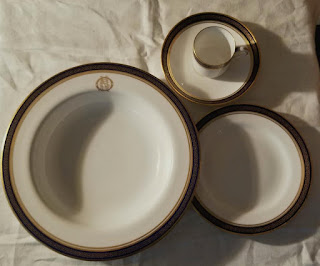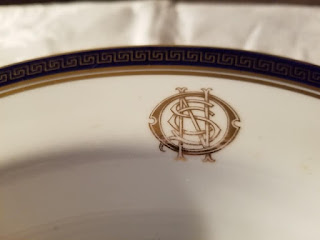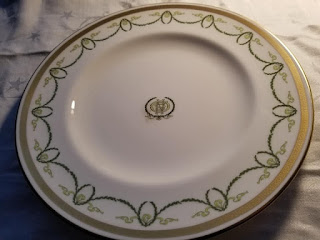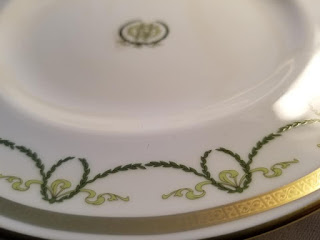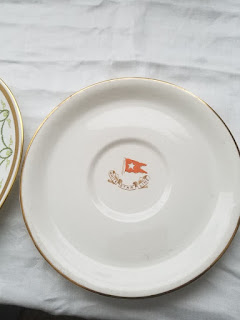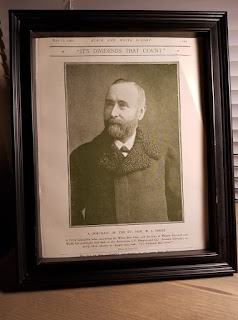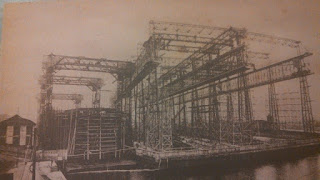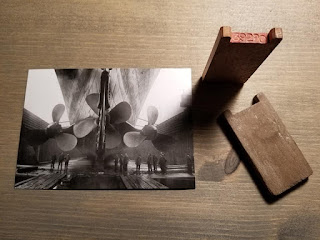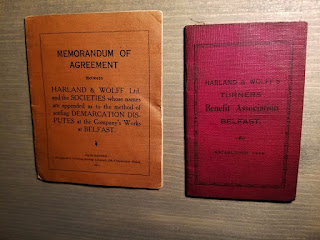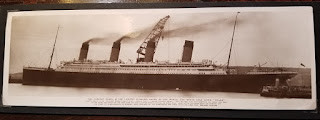On board the Titanic, if you wanted to drop a quick note or chose not spend as much on postage, you sent a postcard. If you had more to say, you wrote a letter on the stationary available throughout the public spaces. If you wanted send something special to someone special, you spent a little extra to purchase a silk postcard in the barber shop which had souvenirs available for purchase. Silk postcards at the time were available on many ships advertising the ships they were on, typically depicting either a profile view of the ship or "hands across the sea" which depicted two hands meeting with flags representing the country of origin and the country which the ship was destined to (typically American and British).
This is a postcard made for the Titanic to be sold in her barbershop. There aren't very many of these out there, but there's a good bit for something only meant for a ship that sank on her maiden voyage. At least 3 were sent out from the ship. I speculate there was a box or two either left over from the ship or kept in storage to restock the Titanic when she returned to the UK. These are very rare to come across and very desirable amongst collectors today.
Monday, October 22, 2018
Wednesday, October 17, 2018
Expedition: Titanic
These are items from the estate of maritime artist Michael Ralph who was there for the 1996 expedition to the Titanic during which they recovered multiple artifacts including the Big Piece.
This brochure details the dives and schedules for people planning to join the expedition.
These ship blueprints were handed out one of the ships participating in the 1996 expedition which show the layout of the different decks of the ship.
This photo mosaic is one of 4 printed off and handed to crew members of an expedition before they went down to the wreck site they used them at the wreck site for reference points as they explored and decided what to recover. The photo mosaic is of the debris field near the stern section with notes pointing out different artifacts.
This is a really cool piece. It's a Reaserch & Recovery Expedition 1994 - Dive Plot. The plots are real time tracking for every dive on the wreck site and serve as a recorded archive. Transducers are dropped on the seabed, triangulating the wreck site, it is these instruments that determine the location and orientation of the submersible, which are combined with the relative position data from the SBL system to establish the position of the tracked target in earth coordinates, through Satellite orientation via the Mother ship, the Nadir. A short baseline (SBL) acoustic positioning system is underwater acoustic positioning systems that are used to track underwater activity and routing of the submersible, Nautile. A typical mission of a site will span several dives, as tasks such as initial investigation, still image acquisition and video transects are gradually completed. A critical element in these dive series is to show prior-dive search coverage, so that a successive dive can be targeted at a previously unvisited area. This is done by producing a cumulative coverage plot of the dive site. The plot, which is updated during and after every dive, is displayed as a background map on the navigation screen thus providing guidance for the ongoing dive. The precise plot and coordinates are then cross referenced with crew dive logs, to precisely place and record the recovered location of an artefact, archived in the artefact seabed archeological database. The plots also serve as a safety tracking system should communications are lost with the Nautile during a dive.
In order to reach the wreck of the Titanic, it takes descending about 12,500 feet to the wreck site. To demonstrate, the great amount of pressures down at the bottom of the sea, styrofoam cups such as this were attached to the submersibles and brought down with them. As they descended to the wreck site, all the air was squeezed out reducing the cups to sizes and shapes much different from what they were previously.
Sunday, October 14, 2018
Chief Officer Henry Wilde
Chief Officer Henry Tingle Wilde (1872-1912) was a family man who was also a man of the sea. He had a wife and children at home in Liverpool and he had multiple ships in which he served as officer. His life was full of success as he rose in rank and did well in the White Star Line, and one which had joys such as his family, but it also had much tragedy. He did miss his family quite a bit while he was away and that coupled with his father in law Taid passing away of cancer and a short time later, his wife dying along with their twins in 1910 made him very depressed. But he carried on, being transeferred to Chief Officer of the RMS Olympic in 1911, which at that time was the largest, most luxurious ship in the world. In 1912, the original plan was for Wilde to become captain of the RMS Cymric and multiple officers (some of whom were on the Olympic) to take the Titanic on her maiden voyage. Alas, the RMS Cymric's voyage was cancelled due to the coal strike. Shortly before the Titanic's maiden voyage, it was decided to change the line up of the Titanic officers. Chief Officer Murdoch and 1st Officer Lightoller were temporarily demoted a rank and 2nd Officer David Blair left the ship at Southampton to make way for Chief Officer Wilde to help the Titanic on her maiden voyage. The move is often attributed to the fact he had experience with the Olympic which was of similar size to the Titanic and not many officers had experience with ships that large. Wilde is one of the more underrated officers of the Titanic. Despite the fact he was Titanic's 2nd highest ranking officer and fairly active throughout the ship, he isn't talked about as much during the sinking. But his presence was definitely all over the Boat Deck during the launching of the boats. We know he ensured the senior officers did have guns to keep order among the passengers in case of panic and he was actively supervising the loading and launching of the lifeboats. His name has also been put forward as possibly the officer that committed suicide, since he was last seen working near the spot the officer suicide supposedly happened. The last confirmed sighting of him was as he was trying to launch Collapsibles A and B as the sea washed the boats and those on deck away from the ship. His body was never recovered. His remaining children were cared for during the rest of their upbringing by his sister in law and brother in law.
If you would like to learn more about Henry Wilde, there is no better source than the man himself. And there is no other place to read his letters so completely than in "Sincerely, Harry" by Michael Beatty. This collection of letters which includes the letter above will give you a glimpse into his largely unknown life and allow you to get to know the man himself. You can get the book here: http://www.lulu.com/shop/michael-beatty/sincerely-harry/paperback/product-23423507.html
This letter written in 1909 was sent by Henry Wilde as he was serving as Chief Officer of the RMS Canopic. Around the time he wrote this letter, his father in law "Taid" had just become very ill with cancer which caused him great concern. This letter written to his brother in law, Owen Williams. It seems from his other letters that he confided in his in laws quite a bit, expressing his feelings with quite a bit of honesty.
Dear Mr. Williams Thank you very much for you letter which was awaiting me on arrival here on Monday evening. It was with the deepest regret that I read your letter and with the very sad news about Taid, and I fear he must be in a very bad way. I can't tell you how it has upset me to have such a report from both Dr. Taylor and McKenna. I had no idea that Taid was in such a serious way. Of course I quite understand that Pollie would not be aware that his case was so hopeless. She has been living in hopes that the Doctors were doing something for him, if not able to make a complete cure, to at least prolong the growth of the disease. I am afraid it will be a great shock to all when they hear such news and my sympathies go out o them altho so far away. I notice what you say about Taid's private affairs which I will treat with every confidence, but must tell you that I very much regret that Taid should have choosen me to have anything to do with his affairs. Of course you will quite understand what I mean without my going into details and I would very much prefer to be an outsider when the end comes. Taid has never in any way given me to understand that I would have anything to do with his affairs in any way and it is rather a surprise for me to hear from you. Had I known I would certainly have asked him to leave my name out altogether. I have decided to write Capt. Murray and ask him to transfer me too one of the home boats which will be some comfort to Pollie if I am able to be in Liverpool every few weeks. I cannot say what he will have to offer me in the Liverpool ships but anything will be preferable to this, as I have never really settled down in this trade. I will probably hear from him in Naples what he intends to do, and if he relieves me will possibly be on our return to this port. As regards Ada's money I am quite in the dark about that. Pollie I think did mention that some change taking place in the investment but no details and I have not heard anything about same since. I am sorry that on top of your own business worries you should have by Sister's also and I am grateful to you for your kindness to her and am quite sure you will do the best you can for her. I have nothing of interest to tell you about myself or my life out here, the same routine day after day and a constant longing for some change of place. I had a letter from Annie which I should have received last voyage please thank her for the same. I wrote Annie from Gibralter. I trust that you are all keeping well at home during the severe weather. I notice by the papers that the weather in England has been very bad. Give my love to Annie and the twins and kindest regards to the boys and yourself. From Yours Sincerely, Harry
RMS Titanic
When the Titanic was certified to carry mail, it was assigned the prefix R.M.S Titanic which stood for Royal Mail Ship. She had a mail hold below decks which carried thousands of parcels of mail and 5 postal clerks were assigned to sort through the mail during the trip and ensure they were transferred to the US Government for mailing when they got to the United States. Of course, with not as much to do on board for fun, people often took to writing letters to friends and family back home to update them on their lives or tell them of the exciting voyage. The White Star Line was happy to accommodate them by selling postcards in the barber shop and having stationary available. The mail room was one of the first rooms to flood when the Titanic struck the iceberg and none of the postal clerks on board survived.
Saturday, October 13, 2018
Collecting Titanic Memorabilia
When it comes to collecting Titanic Memorabilia, some look at the price tags of menus or deck chairs and automatically assume they can't afford it. Others remain content with replicas or generic stuff with "Titanic" on them. The fact is you can collect affordably without spending thousands and thousands of dollars.
1. Determine The Purpose of Collecting
Before spending a dime on anything, it always best to ask, "Why?" Determining the purpose of your collection will allow you to put more of a focus on what you're looking for and where you look. Some for instance are mostly interested in the passengers and crew, while others are interested mainly in the movie. I collect for the stories each item tells and the connection it gives to the people on board. When you determine the "Why?," the rest will fall into place.
2. Research, Test, Identify
The next thing you want to do is research, test, and identify the items you desire or choose to purchase. When it comes to collecting authentic memorabilia, there are a TON of fakes out there. The most notable recent fakes are people on Ebay selling antique silverware which they've added the White Star Line logo to. Just like those who work at a bank who learn how to tell the difference between government issued and counterfeit bills, you want to study the originals as thoroughly as you can. With historical items, you also want to get the provenance of such items. Find out if there is a chain of ownership dating back to the time of Titanic or connecting it directly to the Titanic. In doing so, you eliminate the risk of purchasing fakes and being more specific with what you're looking for.
3. Learn Where To Look
Titanic items show up in various places, sometimes just randomly. From Ebay to auction houses to websites, you can find Titanic memorabilia if you know where to look and what to look for. After following step 2 above, you want to pay attention to what's available, how often they come available, and for what prices. That way, you can best determine when and where to purchase those precious new additions to your collection.
4. Make Friends
I will never advocate making friends with people just to use them for certain purposes. Friendships must always be based on trust and loyalty first and foremost. However, it cannot be denied that having collector friends is also very beneficial. People who have collected longer will have more knowledge and insight into what to look for and where. Sometimes, they will even be willing to part with some of their collection, allowing you the opportunity to own treasured items. When most collectors part with items, it does their hearts good to see them go to good homes that will value and treasure them as historical artifacts.
5. Realize That This Is Temporary
In the grand scheme of things, you need to realize that what you are doing is acting as caretaker of these historical items for the next generations. With the last of the survivors gone, the last things that tell these stories are the accounts and the items left behind. By taking good care of these items, you are ensuring that they are passed on to the next generations so the stories continue to be told and enjoyed. With whatever you collect, look up how best to preserve and take care of these items so they can be in the same condition leaving your hands as they did when they came into them. Find out things that can harm them such as direct sunlight, exposure to moisture, etc., and take necessary steps to ensure their preservation.
6. Enjoy it!
Despite the serious nature of collecting items related to the Titanic, do what you love and are passionate about. There is much satisfaction and much to enjoy about it too. From creating displays for memorabilia and framing pictures, to making them centerpieces in your home making interesting conversations with visitors. There is really no point to doing something like this unless you enjoy some aspect of it.
Tuesday, October 9, 2018
Lady Lucille Duff Gordon
Lady Lucille Duff Gordon (1863-1935) was one of the most interesting women on the ship. She was one of the first major fashion designers of the 20th century and had a huge influence on the fashions of that time and how fashion is done today. She was also one of the more famous survivors, being called to testify in both the American and BOT Inquiries since they were both in Boat No. 1, a boat which was designed to hold 40 people and instead had 12. They never went back and her husband, Sir Cosmo Duff Gordon, later gave each of the crew money to help them since they lost everything on the Titanic and their pay stopped when she sank. This was seen as bribery to not go back for the people in the water and despite efforts to clear their names, they were ostracized from society afterwards. This magazine page 1916 advertises her clothing and includes a photo of her and a facsimile autograph from her.
Missed The Boat
This book titled "If God Be With Us" was published in 1913 and was owned by a man named Reverend J. Stuart Holden. Rev. Holden (1874-1934) was a vicar of St. Paul's Church in London. He was planning to do a speaking tour in America and booked passage in 1st class on the Titanic. His wife got ill shortly before the voyage and he ended up cancelling his passage. He saved the ticket envelope and after the disaster, he framed it, and wrote, "WHO REDEEMETH HIS LIFE FROM DESTRUCTION."
Monday, October 8, 2018
Jacques and Lily Futrelle
Jacques and Lily Futrelle were known writers originally from Atlanta, GA who wrote plays, novels and articles Jacques Futrelle has been nicknamed the "American Conan Doyle" and the "Father of Modern Science Fiction" because of his mystery and science fiction novels such as "The Problem At Cell 13," "The Thinking Machine," and "The High Hand." They were both on the Titanic and after putting his wife in a boat, he leaned against a railing and smoked a cigar with John Jacob Astor IV. He did not survive the sinking.
This original photo postcard shows the Futrelle's home in Massachusetts. It is believed that that is Mr. and Mrs. Futrelle on the front porch.
This book was the last book written by Jacques Futrelle which was published posthumously by his wife who wrote,
To The Heroes of the Titanic
I Dedicate This My Husband's Book
May Futrelle
Irene Harris
1st class passenger Irene "Renee" Harris (1876- 1969) was one of the lesser known but more underrated passengers on board. She was married to Henry B. Harris who owned and managed the Hudson Theatre in New York City. They were very devoted to each other and were travelling together on the Titanic. She got into a lifeboat, but Henry stayed behind and died in the sinking. Renee never really got over her husband's death and decided to carry on her husband's work, taking over the Hudson Theatre and becoming the first female Broadway producer. She lost most of what she had including the theatre in the great depression and she went into relative obscurity afterwards. When the Titanic Historical Society was created, it was first called the "Titanic Enthusiasts Society." Renee asked, "What is there to be enthusiastic about?" The name was subsequently changed. She married 3 times afterwards, each of which ended in divorce. She said later in life that, "I have had four marriages. But only one husband."
This is a very important photograph taken of Renee Harris. This was taken in 1913, a year after she lost her husband in the Titanic disaster. After going through her period of mourning her husband's death, she decided to take over her husband's business which paved the way for many women to go into show business afterwards.
This photo is a favorite of mine. It's a press photo which shows Renee Harris next to the only thing she saved from the Hudson Theatre when she lost it in the Great Depression, a portrait of Henry.
These are programs from the Hudson Theatre naming the theatre manager as "The Estate of Henry B. Harris" which is how they called it for a while until it was changed to more specifically "Mrs. Henry B. Harris."
The Band Played On
Among the stories from the Titanic disaster, one the ones most people know is that the ship's band played as she sank until the end. There is much debate about them such as what their last song was and how long they played. But what can't be denied is the fact that they went out onto the deck and played songs to keep the passengers calm and entertained as the ship sank beneath them and the boats left in front of them. Because of the legendary status of the band, items related to them are extremely rare, desirable, and expensive as evidenced by Wallace Hartley's violin selling at auction for 1.7 million dollars in 2012. Below are two items I am lucky to be a caretaker of:
This is not directly related to the Titanic, but these are still a little hard to come by. Especially this version which dates pre-Titanic. Titanic had booklets similar to this on board with songs listed by number. If you wanted to hear a particular piece, you would tell a steward who would then convey your wishes to the bandmaster. The bandmaster would say the number of the song and the musicians would play any of the hundreds of songs they could choose from memory.
This booklet used on board the RMS Oceanic is rarer than the one above. I haven't seen any examples of this type of booklet from the Titanic, but it appears to have been used on White Star Line ships in the early 1900s. Just like the with other booklet, it contains a list of music which passengers could browse through and request music from.
During the Victorian/Edwardian Eras, it was not uncommon to have memorial cards made for a loved one who died so people could remember their deaths and by that time would be typically sent out to loved ones who couldn't attend their funerals. This memorial card was for William Theodore Brailey who was the pianist on board the Titanic. He played on several ships including the RMS Carpathia which later rescued the Titanic survivors prior to joining the Titanic in Southampton. He played typically in the Reception Room or Dining Saloon with the quartet for the 1st class passengers. During the sinking, it believed that since he also knew how to play the cello and clarinet, he got one of those instruments and joined the band on deck. He didn't survive the sinking and his body was never recovered.
RMS Olympic
The RMS Olympic was the Titanic's older twin sister ship. The two ships were virtually identical on many levels and were built at the same time by some of the same people. The Olympic came first, followed by the Titanic, followed by the Britannic. Of the three sister ships, it was only the Olympic which did not sink. Rather, she had a long glorious career which included transporting many celebrities such as Charlie Chaplin, Madame Curie, Clifton Webb, Sir Arthur Conan Doyle, and others. In 1935, she was scrapped and her fittings were bought at auction and installed into various hotels and private homes throughout Great Britain. Below are some pieces of the Olympic I've acquired.
C-82
This is a wood section from 1st class cabin C-82. Done in the Italian Renaissance style, C-82 was in my opinion one of the most beautiful cabins on board. It was taken out of the Olympic during her scrapping and installed in a hotel until they were taken out and auction off. On board the Titanic, 1st class passenger Harry Widener stayed in C-82 and the cabin was sadly destroyed during the break up.
This piece is some trim from a 1st class corridor of the RMS Olympic. Olympic had miles of corridors which allowed access throughout the ship. This piece was installed in the Haltwhistle Paint Factory for years before it was taken out and auctioned off.
This is an extremely rare section of carpet from the 1st class Lounge RMS Olympic surrounded by the detailed handcarved wood in the Louis XV style, large windows, and adorned by ornate cartel clocks and a statue of Diana, godess of the hunt on the fireplace mantle with beautiful chairs and tables available for the passengers' comfort. There was a large bookshelf standing in front of one wall graced with dozens of books available for the passengers to borrow. Above this room in the center was an enormous and gorgeous chandelier which gave off a lot of light surrounded by smaller chandeliers lighting the alcoves and sides. Being among the most ornate rooms on the ship and located centrally on A Deck, it was popular spot for socializing and conversing with fellow passengers.
John Jacob Astor VI
This is a photo from my collection of John Jacob Astor VI taken on board the RMS Berengaria. 1st class passenger Madeline Astor was pregnant with him on the Titanic and his father, John Jacob Astor IV, was the wealthiest man on board. John Jacob Astor IV requested to accompany his wife into the lifeboat due to her delicate condition, but he was refused to which he calmly said good bye to his wife and stepped back. He did not survive. John Jacob Astor VI was born in August of that year and dubbed the "Titanic Baby" by the press. He inherited some money from his father when he turned 21 and he had a rather comfortable life. When this photo was taken in 1930, Captain Rostron (who was the captain of the Carpathia when they rescued the Titanic survivors) was captain of that voyage. Astor died in 1992 in Miami Beach, FL.
Ethel and Edward Beane
These are photographs from my collection of 2nd class passengers Ethel and Edward Beane. They are unique in that they are one of just two couples in 2nd class that survived intact. Ethel got into Boat No. 9 which was lowered into the water and Edward jumped into the water afterwards and swam to her lifeboat. It is believed Ethel was pregnant on the Titanic because in January 1913, she gave birth to a stillborn baby. Edward passed away in 1948, but Ethel lived for much longer and died in 1983 at the age of 93.
Major Archibald Butt
1st class passenger Major Archibald Butt was more influential than he was wealthy. During his life, he grew up in poverty in Georgia during the Reconstruction Era and made himself successful through determination. He was a reporter/journalist/correspondent for multiple newspapers and Army officer. By 1912, "Archie" (as he was known to his friends) had achieved the rank of Major and was a military aide to President Taft. He was on leave returning home from delivering a message to the Pope from the President and when the Titanic sank, Archie never made any attempt to get a place in one of the lifeboats from the Boat Deck. There are many reports of his bravery during the sinking and he sadly didn't survive.
Above are photographs taken during Archie's time with President Taft. In many photos of Taft's day to day life, Archie is typically not far away. Taft trusted and confided in him and Archie made sure things ran smoothly around him.
Above is a 1912 edition of "Both Sides of the Shield," a novel Archie wrote which was published first in 1906. When he died in 1912, the J.B. Lippincott republished his book in his memory and got his good friend President Taft to write the forward, expressing his thoughts about Archie's life and heroism.
Above are photographs taken during Archie's time with President Taft. In many photos of Taft's day to day life, Archie is typically not far away. Taft trusted and confided in him and Archie made sure things ran smoothly around him.
Above is a 1912 edition of "Both Sides of the Shield," a novel Archie wrote which was published first in 1906. When he died in 1912, the J.B. Lippincott republished his book in his memory and got his good friend President Taft to write the forward, expressing his thoughts about Archie's life and heroism.
Stewardess Emma Bliss Book
This book belonged to a stewardess on the Titanic named Emma Bliss (1866-1912) who survived the disaster. She lived to the age of 93, working hard and staying involved in some Titanic survivor circles. The book inscribed,
May 9th, 1916
To my dear friend, Emma J. Bliss a true survivor!
Dear Amy,
I hope you enjoy this happy birthday!
Love, Stella
For more information about Emma Bliss, here are some links to more information about her fascinating life!
https://www.encyclopedia-titanica.org/titanic-survivor/emma-bliss.html
http://www.beachmetro.com/2012/04/18/titanic-movies-draw-inspiration-real-life/
Sunday, October 7, 2018
Titanic China: 1st Class
There were multiple patterns used on board the Titanic. While 2nd and 3rd class just had one pattern each, 1st class had several. Below are some examples of patterns used on board which I have collected.
Wisteria
This pattern, commonly called "Wisteria" or "Brownfield Wisteria," was supplied to the White Star Line by Stonier & Co. in Liverpool. It was used in primarily 1st class on multiple White Star Line ships of the time. This china was used in the 1st class Dining Saloon and Reception Room, basically the standard 1st class areas which were included in the price of the 1st class ticket. This cup and saucer pictured above has the dates 2/1912 and 3/1912, the same batches some of Titanic's china came from.
Greek Key
This pattern, known as "Greek Key," was supplied by Copeland and Spode. It was used on board the Olympic and Titanic in the Cafe Perisian and A La Carte Restaurant. Rather than use the famous White Star Line burgee you see on so many other White Star Line china pieces, they opted to use the OSNC logo with stands for "Oceanic Steamship Navigation Company," the parent company of the White Star Line. The simple beauty of the pattern makes it simply gorgeous. The bowl plate is an original from the Olympic. The demitasse cup and saucer and the side plate in the top photo on the other hand are the same pattern made by the same company, though they were not used on a White Star Line steamer. They do serve to compliment the bowl plate, allowing you to imagine using these pieces during dinner on an Olympic Class liner.
Royal Crown Derby
This pattern, known as "Royal Crown Derby," (the makers) was inspired by the Louis XVI style and was used in the A La Carte Restaurant. The restaurant itself was not included in the 1st class ticket. It was owned and operated by Luigi Gatti and his Italian staff. For those who chose to, they could dine in the gorgeous restaurant surrounded by French walnut paneling. On the last night of the Titanic's voyage before her sinking, the Wideners hosted a dinner party with Captain Smith as a guest of honor. The creme of the crop of society on board dined together and for some, it would be their last meals. The plate is a replica made by Royal Crown Derby which is still in existence for the 100th anniversary of the disaster.
Deck Service
This saucer, sometimes mistaken for 3rd class, was used for deck service in 1st and likely 2nd class. The thing that differentiates this from 3rd class china is the gold rim around it. The saucer is rather large, probably because there was a greater risk of spilling a drink on deck. A passenger could rent a deck chair and steamer blanket, sit down, and read a book while sipping tea supported by this saucer and watch the sea pass by beyond the deck.
Building The Dream
Titanic's construction lasted for 3 years of her existence, meaning it took up most of her life. There is quite a bit out there from Harland and Wolff in Belfast, Northern Ireland where she was built and in 2017, I had the privilege and honor of visiting the spots where she was built and touring the museums there.
This magazine features a photo of Lord William Pirrie, a man responsible for the Titanic's construction. He was the president of Harland & Wolff at the time and even served as Lord Mayor of Belfast. Rumor has it he and J. Bruce Ismay (the managing director of the White Star Line) came up with the idea of Titanic and her sisters in 1907, though this rumor has largely been discredited. His brother in law, Alexander Carlisle, and his nephew, Thomas Andrews were among the main designers for Titanic.
These postcards show photos of the Arrol Gantry which is the cradle where the Titanic and her sisters were built. Prior to construction, the original gantries had to be demolished and the Arrol Gantry built to accommodate the enormous size of the new upcoming liners. These gantries were used until the 1970s and were among the largest in the world at the time they were built.
This magazine features a photo of Lord William Pirrie, a man responsible for the Titanic's construction. He was the president of Harland & Wolff at the time and even served as Lord Mayor of Belfast. Rumor has it he and J. Bruce Ismay (the managing director of the White Star Line) came up with the idea of Titanic and her sisters in 1907, though this rumor has largely been discredited. His brother in law, Alexander Carlisle, and his nephew, Thomas Andrews were among the main designers for Titanic.
These postcards show photos of the Arrol Gantry which is the cradle where the Titanic and her sisters were built. Prior to construction, the original gantries had to be demolished and the Arrol Gantry built to accommodate the enormous size of the new upcoming liners. These gantries were used until the 1970s and were among the largest in the world at the time they were built.
These are pieces and fragments from the Arrol Gantry which was used to build the Titanic. These were picked up from the very spot where they once rested.
These two time keeping boards were used for clocking in and out while working at Harland and Wolff. Each one had a unique number which was recorded when they came into and left work. If the workers required special tools from the shop, they would have to give up the boards until they returned the tools. If they didn't turn them in at the end of the day, they didn't get paid.
These booklets were printed and distributed throughout Harland and Wolff as away for people to stay informed about questions and issues. Ireland at the time was not the most peaceful of countries and there were many internal conflicts over a variety of issues. Above is a booklet about disputes and demarcation and a book about the Benefit Association.
This postcard features the Titanic under construction in the Arrol Gantry at Harland and Wolff. This postcard is exceptionally rare, showing the Olympic and Titanic being built side by side. Very few original postcards with this view exist.
This rare post-sinking bookpost postcard features a stunning photograph of the Titanic taken April 1, 1912, the original scheduled day of the sea trials. Because of the high winds (as evidenced by the smoke coming out of the smokestacks), the sea trials were rescheduled. The largest floating crane in the world at the time, Hercules, can be seen just behind her. It was used to install the boilers, engines, funnels, and other heavy machinery.
Subscribe to:
Posts (Atom)
